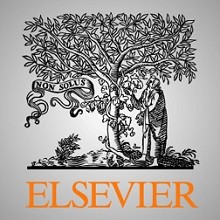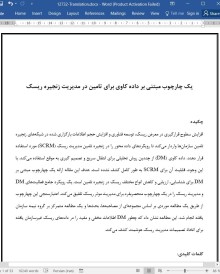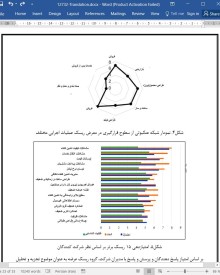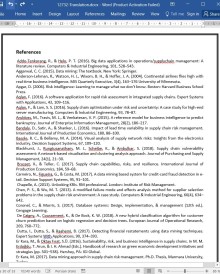
دانلود مقاله یک چارچوب مبتنی بر داده کاوی برای تامین در مدیریت زنجیره ریسک
چکیده
افزایش سطوح قرارگیری در معرض ریسک، توسعه فناوری و افزایش حجم اطلاعات بارگزاری شده در شبکه های زنجیره تامین سازمان ها واردار می کند تا رویکردهای داده محور را در زنجیره تامین مدیریت ریسک (SCRM) مورد استفاده قرار دهند. داده کاوی (DM) از چندین روش تحلیلی برای انتقال سریع و تصمیم گیری به موقع استفاده می کند. با این وجود، قابلیت آن برای SCRM به طور کامل کشف نشده است. هدف این مقاله ارائه یک چهارچوب مبتنی بر DM برای شناسایی، ارزیابی و کاهش انواع مختلف ریسک در زنجیره تامین است. یک رویکرد جامع فعالیت های DM و مدیریت ریسک را در یک چهارچوب منحصربفرد برای مدیریت موثر ریسک تلفیق می کند. اعتبارسنجی این چهارچوب از طریق یک مطالعه موردی بر اساس مجموعه ای از مصاحبه ها، بحث ها و یک مطالعه متمرکز بر گروه نیمه سازمان یافته انجام شد. این مطالعه نشان داد که چطور DM اطلاعات مخفی و مفید را در داده های ریسک غیرسازمان یافته برای اتخاذ تصمیمات مدیریت ریسک هوشمند کشف می کند.
1. مقدمه
ریسک موضوع مهمی است که ثبات و رقابت پذیری زنجیره های تامین را تهدید می کند (Aqlan & Lam, 2016; Brusset & Teller, 2017). فراوانی، شدت و تنوع ریسک های زنجیره تامین (SC) سریع هستند که ناشی از افزایش جهانی سازی ، انتظارات مشتری و چرخه کوتاه مدت محصول در شبکه های SC هستند (Norrman & Jansson, 2004; World Economic Forum, 2017). زنجیره های تامین در معرض ریسک های درونی و بیرونی متنوع و به شکل ها و احتمالات و تاثیرات متنوعی قرار می گیرند (Chen & Wu, 2013; Guertler & Spinler, 2015). این ریسک های می توانند حاصل منابع مختلفی مانند تقاضای نامشخص ، وقفه در عرضه ، نرخ ارز بی ثبات بی ثباتی سیاسی ، بازارهای پویا مصرف کننده و حتی حوادث غیرمترقبه مانند حوادث کار، حملات سایبری، بلایای طبیعی و تروریسم باشد (Er Kara, & Oktay Fırat, 2017; Rajagopal, Venkatesan, & Goh, 2017). عوامل تحریک کننده ریسک های SC، روابط و نتایج آن ها برای اندازه گیری بسیار پیچیده است که به دلیل ماهیت پیچیده این شبکه ها است (Vilko & Hallikas, 2012; Brusset & Teller, 2017)؛ و نیازمند برخورد با مقادیر زیادی ازمنابع اطلاعاتی/داده پراکنده و متفاوت هستند (Schlegel & Trent, 2014; Yu, Chavez, Jacobs, & Feng, 2018).
هدف، تنوع، حجم و سرعت داده ها به طور ثابتی در حال افزایش است که به دلیل پیشرفت های صورت گرفته در فناوری های اطلاعات و ارتباطات است (Addo-Tenkorang & Helo, 2016). پیشرفت های فناورانه و اطلاعات رو به رشد حجم زیادی از اطلاعات را به سازمان ها تحمیل می کند تا از رویکردهای تصمیم گیری مبتنی بر داده استفاده کنند (Lee, Zhou, Souza, & Park, 2016; Long, 2018). تعداد زیادی از سازمان ها شروع به استفاده از روش های هوش کسب و کار (BI) داده کاوی برای تصمیم گیری موثر، هوشمندانه و به موقع کرده اند (Heaney, 2015; Wu, Yue, Jin, & Yen, 2016; Ponemon Institute, 2017). DM نقش مهمی در دستیابی به دیدگاه های ارزشمند عوامل پتانسیل ریسک SC، منابع آن ها، اثرات و روابط بین آن ها دارد (Ranjan & Bhatnagar, 2011). روش های DM می توانند در مراحل مختلف SCRM استفاده شوند تا سیستم های فعال و واکنشی را توسعه دهند (Wu, Chen, & Olson, 2014; Lee, Kim, & Lee, 2017). مطالعات مختلفی انجام شده که از روش های DM برای شناسایی و ارزیابی ریسک های انتخاب شده در زمینه های مختلف تحقیقاتی استفاده می کنند (e.g. Ruiz-Torres, Mahmoodi, & Zeng, 2013; Le, Arch-int, Nguyen, & Arch-int, 2013; Blackhurst, Rungtusanatham, Scheibe, & Ambulkar, 2018). با این وجود، علی رغم علاقه رو به رشد تحقیقاتی، تحقیقات دانشگاهی بسیار کم و پراکنده هستند. و چهارچوب سیستماتیکی استفاده از داده های غیر سازمان یافته (ریسک) برای SCRM وجود ندارد (Tobback, Bellotti, Moeyersoms, Stankova, & Martens, 2017). علاوه بر این، نحوه تبدیل مشکلات مدیریت ریسک به مشکلات DM برای تصمیم گیری در مورد مدیریت ریسک قوی، همچنان یک چالش است. یک چهارچوب جامع با توانایی تلفیق رویکردهای DM و مدیریت ریسک برای درک بهتر داده های بزرگ مطلوب است. این مقاله مرتبط با مقاله ارائه شده در یک چهارچوب جدید SCRM است که توسط رویکردهای DM برای تشخیص، ارزیابی و کاهش انواع مختلف ریسک های SC حمایت می شود.
6. جمع بندی
حجم داده ایجاد شده و انتقال آن در خلال شبکه SC حاصل پیشرفت ها در فناوری های اطلاعات و ارتباطات، افزایش همکاری بین سهامداران و انتقال دیجیتالی زنجیره های تامین با اتخاذ فناوری های صنعت 4.0 (مانند RFID، اینترنت اشیاء و سیستم های فیزیکی سایبری) است. این پیشرفت های فناوری و نوآوری ها در کسب و کار مدیران SC را مجبور می کند تا تصمیمات مبتنی بر داده بگیرند. با وجود علاقمندی رو به رشد در صنعت، تحقیقات دانشگاهی در استفاده از این رویکردهای مبتنی بر داده برای مدیریت ریسک SC وجود ندارد. این مطالعه در ارتباط با مقالاتی است که در حال ایجاد چهارچوب جامع مبتنی بر DM برای SCRM هستند. اقدامات کلیدی دربرگیرنده مدیریت ریسک و DM برای ایجاد یک نقشه راه ترکیب می شوند تا به یک سیستم موثر و هوشمند مدیریت ریسک برای زنجیره تامین دیجیتال حال حاضر برسند. علی رغم توسعه یک بستر SCRM برای شرکت ها، چهارچوب پیشنهادی راهنمای جامعی را برای جمع آوری، تجزیه و تحلیل، پایش و مدیریت سیستماتیک داده های ریسک SC از چند منبع اطلاعاتی فراهم کرده است. این مطالعه نشاندهنده نحوه پشتیبانی DM از کشف اطلاعات مخفی و مفید در داده های ریسک غیرسازمان یافته برای اتخاذ تصمیمات مدیریت ریسک هوشمند است.
داده کاوی حاصل از چهارچوب SCRM منحصر به فرد است و در گذشته مورد بررسی قرار نگرفته است. این مطالعه با تلفیق مدل های فرایندی مختلف، رویکرد جامعی را ارئه داده است که کاربردی و قابل اجرا است، و نشاندهنده یک نمونه مطالعه موردی است. این داده تلفیقی و سازمان یافته حاصل از این روند به طور جزئی اجرا شده و شرکت های جهانی مورد آزمایش قرار گرفته است. موضوعات اجرای کاربردی و پیشنهادات از طریق مشاهدات و یافته های مطالعه موردی فراهم می شوند. این مدل با استفاده از یک شرکت موردی تست شد و در نتیجه، قابلیت استفاده، یادگیری و محدودیت های چهارچوب برای تعمیم دادن دارای دشواری هستند. با این وجود، انتظار می رود مدل مدیریت ریسک مبتنی بر DM پیشنهادی از طریق ایجاد درک بهتر از ریسک های SC، اثرات بحرانی آن و وابستگی متقابل بین آن-ها، سازمان ها را هوشمندتر کند. استراتژی های کاهنده فعال و واکنش پذیر می توانند بر اساس ارزیابی های داده ریسک توسعه یابند. این بررسی بازتابی از قابلیت ابزارها و روش های DM برای افزایش وضوح و واکنش پذیری SCها است. طی این مطالعه، مشاهده می شود که DM برنامه های کشف دانش تعاملی و توزیع شده را ارائه می دهد و به طور کلی قابلیت بالایی در SCRM و SCM دارد. انتظار می رود که این بررسی اصول ابتدایی برای تحقیق و توسعه بیشتر در چهارچوب های مبتنی بر داده برای مدیریت ریسک زنجیره تامین فراهم کند.
Abstract
Increased risk exposure levels, technological developments and the growing information overload in supply chain networks drive organizations to embrace data-driven approaches in Supply Chain Risk Management (SCRM). Data Mining (DM) employs multiple analytical techniques for intelligent and timely decision making; however, its potential is not entirely explored for SCRM. The paper aims to develop a DM-based framework for the identification, assessment and mitigation of different type of risks in supply chains. A holistic approach integrates DM and risk management activities in a unique framework for effective risk management. The framework is validated with a case study based on a series of semi-structured interviews, discussions and a focus group study. The study showcases how DM supports in discovering hidden and useful information from unstructured risk data for making intelligent risk management decisions.
1. Introduction
Risk is an important issue threatening sustainability and competitiveness of supply chains (Aqlan & Lam, 2016; Brusset & Teller, 2017). The frequency, severity and variety of supply chain (SC) risks are accelerating as a result of increasing globalization, customer expectations and shorter product life cycles in SC networks (Norrman & Jansson, 2004; World Economic Forum, 2017). Supply chains are exposed to various internal and external risks with different forms, probabilities and impacts (Chen & Wu, 2013; Guertler & Spinler, 2015). These risks can result from a wide variety of sources including uncertain demand, supply interruptions, volatile exchange rate, political instability, dynamic consumer markets and even unexpected events such as work accidents, cyber-attacks, natural disasters and terrorism (Er Kara & Oktay Fırat, 2017; Rajagopal, Venkatesan, & Goh, 2017). The triggering factors of SC risks, their relationships and consequences are very complex to measure due to the complex nature of these networks (Brusset & Teller, 2017; Vilko & Hallikas, 2012); and require dealing with huge amounts of different and distributed data/information sources (Schlegel & Trent, 2014; Yu, Chavez, Jacobs, & Feng, 2018).
The scope, variety, volume and velocity of data is constantly increasing due to advances in the information and communication technologies (Addo-Tenkorang & Helo, 2016). Technological developments and the growing information over-load drive organizations to use datadriven decision-making approaches (Lee, Zhou, Souza, & Park, 2016; Long, 2018). A growing number of organizations have started to use Business Intelligence (BI) and Data Mining (DM) approaches to make efficient, intelligent and timely decisions (Heaney, 2015; Ponemon Institute, 2017; Wu, Yue, Jin, & Yen, 2016). DM plays a critical role in gaining valuable insights into potential SC risk factors, their sources, impacts and inter-relationships (Ranjan & Bhatnagar, 2011). DM techniques can be used in various stages of SCRM to develop proactive and reactive systems (Lee, Kim, & Lee, 2017; Wu, Chen, & Olson, 2014). There are various studies that employ DM techniques for detection and assessment of selected risks in different research fields (e.g. Ruiz-Torres, Mahmoodi, & Zeng, 2013; Le, Arch-int, Nguyen, & Arch-int, 2013; Blackhurst, Rungtusanatham, Scheibe, & Ambulkar, 2018). However, despite the growing research interest, the academic literature is scarce and distributed. There is lack of a systematic framework for utilizing unstructured (risk) data for SCRM (Tobback, Bellotti, Moeyersoms, Stankova, & Martens, 2017). Furthermore, how to convert risk management problems into DM problems for making robust risk management decisions remains a challenge. A holistic framework with an ability to integrate DM and risk management approaches is highly desirable to better comprehend the big data. This paper contributes to the literature by presenting a novel SCRM framework supported by DM approaches for identification, assessment and mitigation of different types of SC risks.
6. Conclusion
The volume of data generated and transmitted across SC networks is on rise with developments in communication and information technologies, increasing collaboration between stakeholders and digital transformation of supply chains with the adaptation of Industry 4.0 technologies (such as RFID, Internet of Things and cyber physical systems). These technological enhancements and business innovations are driving SC managers in making data-driven decisions. Despite growing interest in the industry, academia has been lagging in using data-driven approaches to manage SC risks. The study contributes to the literature by developing a comprehensive DM-based framework for SCRM. Key activities involved in risk management and DM are combined for developing a road map to achieve effective and intelligent risk management systems for today’s digital supply chains. Besides developing a SCRM platform for companies, the proposed framework provides a comprehensive guide to systematically collect, analyze, monitor and manage SC risk data from multiple information sources. The study showcases how DM supports in discovering hidden and useful information from unstructured risk data for making intelligent risk management decisions.
Data mining driven SCRM framework is unique and has not been addressed in the past. By integrating different process modules, the study provided a holistic approach, which is practical and easy to implement, demonstrated using a case study example. This integrated and structured data driven procedure is partially implemented and tested in a global company. Practical implementation issues and suggestions are provided through the observations and findings of the case study. The model was tested using a single case company and thus, the applicability, learnings and limitations of the framework are difficult to generalize. However, the proposed DM-based risk management model is expected to make organizations smarter by providing a better understanding of the SC risks, their critical effects and interdependencies between them. Proactive and reactive mitigation strategies can be developed based on the assessment of risk data. The study reflects on the potential of DM tools and techniques to increase visibility and responsiveness of SCs. Following this study, it is evident that DM provides interactive and distributed knowledge discovery applications and has huge potential specifically in SCRM and SCM in general. This study is expected to set an initial basis for further research and developments in the data-driven frameworks for supply chain risk management.
The application part of the framework was limited due to the requirement for technological and workforce investments to implement and test the developed framework. Future research can explore some of the limitations captured in this study. Additionally, there was lack of comparative multiple DM applications to validate the framework. Future research can also focus on implementing the data mining-based SCRM framework in multiple organizations for drawing universal insights.
چکیده
1. مقدمه
2. مرور مقالات
3. روش تحقیق
4. توسعه چهارچوب مبتنی بر داده کاوی
4.1. مروری بر مدل
4.2. ایجاد یک گروه مدیریت ریسک و شناسایی ریسک های مهم
4.3. ساخت یک انبار داده ریسک
4.4. تجزیه و تحلیل داده های ریسک با استفاده از مدل داده کاوی
4.5. تفسیر نتایج مدل DM
5. اجرا و آزمون چهارچوب در یک شرکت نمونه
6. جمع بندی
منابع
ABSTRACT
1. Introduction
2. Literature review
3. Research methodology
4. Development of data mining-based framework
4.1. Overview of the model
4.2. Creating risk management team & identifying main risks
4.3. Building a risk data warehouse
4.4. Analysis of risk data using data mining module
4.5. Interpreting results of the DM module
5. Implementing and testing the framework in a case company
6. Conclusion
References
- اصل مقاله انگلیسی با فرمت ورد (word) با قابلیت ویرایش
- ترجمه فارسی مقاله با فرمت ورد (word) با قابلیت ویرایش، بدون آرم سایت ای ترجمه
- ترجمه فارسی مقاله با فرمت pdf، بدون آرم سایت ای ترجمه



